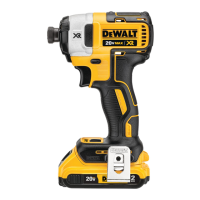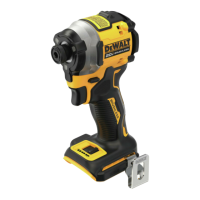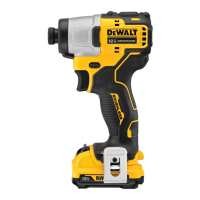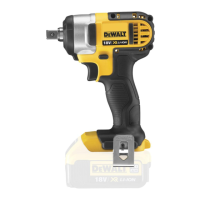11
ENGLISH
When set in reverse, the tool will impact at a normal speed and
rate of 3550 IPM. Upon sensing that the fastener has broken
free, the tool will cease to impact and will reduce speed to help
prevent “run‑off” of loose hardware.
Specifications DCF921
Mode Application RPM
Precision Wrench™ Precision Wrench™ 0–2500 forward
0–2500 reverse
Scaffolding Mode Scaffolding Mode 0–2500 forward
0–2500 reverse
Speed 1 Low Speed Impacting 0–1400 forward
0–2500 reverse
Speed 2 High Speed Impacting 0–2500 forward
0–2500 reverse
Specifications DCF922
Mode Application RPM
Precision Wrench™ Precision Wrench™ 0–2500 forward
0–2500 reverse
Timber Screw™ Timber Screw™ 0–2500 forward
0–2500 reverse
Speed 1 Low Speed Impacting 0–1400 forward
0–2500 reverse
Speed 2 High Speed Impacting 0–2500 forward
0–2500 reverse
Anvil (Fig. A)
WARNING: Use only impact accessories. Non‑impact
accessories may break and cause a hazardous condition.
Inspect accessory prior to use to ensure that it contains
nocracks.
CAUTION: Inspect anvils, detent pins, and hog rings prior
to use. Missing or damaged items should be replaced
beforeuse.
Place the switch in the locked off (centre) position or remove
battery pack before changingaccessories.
Anvil with Detent Pin (Fig.D)
DCF922
To install an accessory on the anvil, align the hole in the side
of the accessory with the detent pin
15
on the anvil
3
. Press
the accessory on until the detent pin engages in the hole.
Depression of detent pin may be necessary to aid installation
ofaccessory.
To remove an accessory, depress the detent pin through the
hole and pull the accessoryoff.
Anvil With Hog Ring (Fig.D)
DCF921
To install an accessory on the hog ring anvil, firmly push
accessory onto the anvil
3
. The hog ring
14
compresses to
allow the accessory to slide on. After accessory is installed, the
hog ring applies pressure to help provide accessoryretention.
To remove an accessory, grasp the accessory and firmly pull
itoff.
OPERATION
Instructions for Use
WARNING: Always observe the safety instructions and
applicableregulations.
WARNING: To reduce the risk of serious personal
injury, turn tool off and disconnect battery pack
before making any adjustments or removing/
installing attachments or accessories. An accidental
start‑up can causeinjury.
Proper Hand Position (Fig. E)
WARNING: To reduce the risk of serious personal injury,
ALWAYS use proper hand position asshown.
WARNING: To reduce the risk of serious personal
injury, ALWAYS hold securely in anticipation of a
suddenreaction.
Proper hand position requires one hand on the main handle
6
.
Usage (Fig. A)
CAUTION: Ensure fastener and/or system will withstand
the level of torque generated by the tool. Excessive torque
may cause breakage and possible personalinjury.
1. Place the accessory on the fastener head. Keep the tool
pointed straight at thefastener.
2. Press variable speed trigger switch
1
to start operation.
Release variable speed trigger switch to stop operation.
Always check torque with a torque wrench, as the fastening
torque is affected by many factors including the following:
‑ Voltage: Low voltage, due to a nearly discharged
battery, will reduce fasteningtorque.
‑ Accessory size: Failure to use the correct accessory size
will cause a reduction in fasteningtorque.
‑ Bolt size: Larger bolt diameters generally require
higher fastening torque. Fastening torque will also vary
according to length, grade, and torquecoefficient.
‑ Bolt: Ensure that all threads are free of rust and other
debris to allow proper fasteningtorque.
‑ Material: The type of material and surface finish of the
material will affect fasteningtorque.
‑ Fastening time: Longer fasten ing time results in
increased fastening torque. Using a longer fastening
time than recommended could cause the fasteners to
be overstressed, stripped ordamaged.

